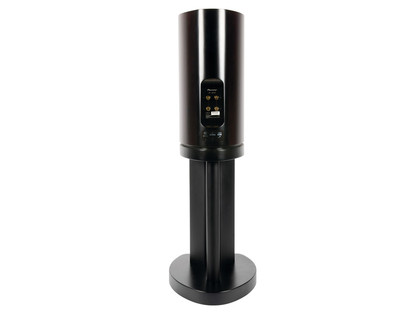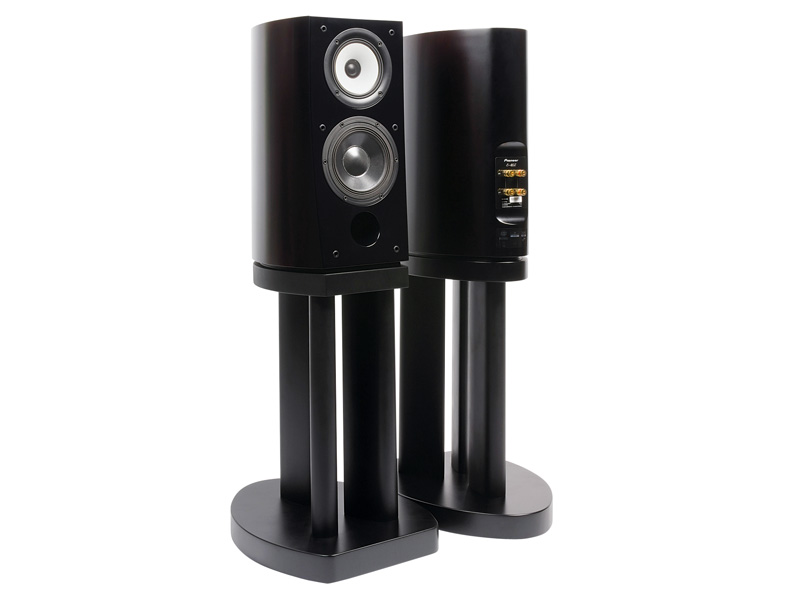TechRadar Verdict
A high-quality performer in terms of smoothness, low coloration and wide dynamic range, but it doesn't provide an S-2EX standard of performance on the cheap, as the sound is a little dull and lacking in excitement.
Pros
- +
Has all the major benefits of a standmount
- +
Clean bass and fine imaging
- +
Sound is smooth and evenhanded
- +
Low cabinet coloration
- +
Wide dynamic range
Cons
- -
Overall balance is laid back and restrained to the point it verges on dull
- -
dynamics seem somewhat lacking in vim and vigour
Why you can trust TechRadar
The S-4EX bookshelf speaker uses drivers designed by the company's ProAudio division TAD (Technical Audio Devices) and are built in Japan.
While the speakers are actually built in China, most of the design work is done in France, assisted by US-based Welsh engineer Andrew Jones, while Britain chips in with evaluation at Air Studios!
Put an S-4EX in a different room from an S-2EX and you'd be hard pressed to say which was which.
Only direct side-by-side comparison makes it obvious that this is the petit pois and the other the cannonball, so similar do they appear at first sight. Although the shape and proportions of these two hefty standmounts are indeed very similar, there are also some substantial differences, as a consequence of which this smaller model costs £3,000 per pair, while its bigger brother carries a rather more eyewatering £5,200 price tag.
The reasons are several. Pioneer's EX-series of top-quality speakers comprise six basic models (or twelve, if you count the beech and teak-veneered variations as different). Those six actually consist of two ranges of three, each consisting of a floorstander, a standmount, and a horizontal centre-front, AV-oriented model.
The S-1/2/7EX threesome came first, and are all somewhat larger and heavier than the S-3/4/8EX models and also use costly beryllium tweeter diaphragms. however, the newer, slightly 'lower tech' and significantly less expensive S-3/4/8EX series has to make do with tweeter diaphragms made from something called 'ceramic graphite'.
The core question that this review should therefore be addressing, is to try and establish to what extent the economies introduced for the newer, less costly S-4EX compromise its performance vis-a-vis the senior S-2EX.
While some of the price difference between the two models is down to a slightly larger enclosure, bass driver and (presumably) heftier construction, the most important difference concerns the tweeter. Exactly what 'ceramic graphite' consists of remains something of a mystery, though Pioneer describes it as: 'one of the lightest and most rigid materials available for diaphragms', and supplied some data comparing it to other tweeter diaphragm materials.
Naturally enough these showed it in a favourable light, probably only bettered by diamond and beryllium, both of which are presumably much more costly to acquire and fabricate. Furthermore, beryllium has environmental issues that some may find objectionable: it's highly poisonous, so although this is unlikely to affect the end-user, one might question whether the mining and processing involved should be condoned.
The S-4EX might be 8Kg lighter than its senior sibling, but it still weighs a considerable 20Kg, which is more than most floorstanders manage, as well as a testament to the sheer quantity of solid engineering that has gone into the enclosure.
The curved sides and back are made by laminating together thin layers of MDF and the total thickness apparently varies between 40mm and 100mm to ensure both high inertia and inert behaviour.

CERAMIC GRAPHITE: We're not sure what it is either but it sounds good
The front panel is sculpted into a concave curve, to better time-align the diaphragms. Although the top and base are flat and parallel, the design takes account of, and cancels the effects of, internal vertical standing waves. The surface is covered in good-quality, satin-finish, real-wood veneer – very dark, almost black, on beech is also available.
The similarly massive partnering stand has received equally hefty construction, for the base, the top slab and three fat verticals. it has an impressively generous stability footprints top and bottom, though the four floor-coupling cones look a little too blunt to penetrate thick carpets.
With more than a nod towards mollycoddling health and safety considerations, a rear stud further ensures floor stability and retaining bolts secure the speaker to the stand.
Although only two drive units are apparently visible, this is, in fact, a three-way design as the smaller uppermost 140mm driver has a 30mm tweeter (the afore-mentioned ceramic graphite affair) mounted down the centre of its 100mm white magnesium alloy cone. The 160mm bass driver has a 35mm voice coil driving a 120mm woven Aramid cone, terminated by a corrugated 'double S' surround formed from polycarbonate urethane.
The bass driver/enclosure combination is reflex loaded by a modest front port, while twin terminal pairs are mounted directly through a flat portion on the rear. The well shaped grille is a fairly hefty affair and leaving it off does reveal the mounting sockets.
Sound quality
Claimed sensitivity is just 85.5dB, an unusually low figure that's significantly below the 87dB indicated by our measurements. Even at 87dB it's somewhat below average, especially as the impedance hovers around four ohms through much of the bass region, while bass extension is realistically restricted to around 33hz, with the ports tuned to 43hz.
The far-field averaged 'power' frequency response looks very well-ordered and is especially smooth above 500hz. Indeed, it's interesting to note that the ceramic graphite tweeter used here delivers a much smoother response than the beryllium unit used in the S-2EX.
However, the overall balance does err on the warm side, output beginning to fall above 700hz and looking quite restrained through the presence zone, in contrast to what we found with the S-2EX, which was stronger around 3Khz and also brighter, if more peaky, in the treble. The pair match was exceptionally good.
Although undoubtedly a smooth and even-handed performer, first impressions of playing music through the S-4EX were that it's a little dull and lacking in excitement. it certainly didn't quicken the blood or enthusiasm in the way its elder sibling had.
Although that first impression was never entirely dispelled, the virtues of this speaker do sneak up on you and while it does seem to lack a little vim and vigour, it's tonally sweet. The overall character is a shade dark and textures are a trifle thickened, but the sound is impressively free from any boxiness and very smooth and easy on the ears.
Superior mid-to-treble coherence is another notable strength and this contributes towards creating a spacious and well-focused stereo soundstage. The positive benefits of standmount operation are clearly in evidence, not only in the precision of the imaging and the freedom from boxy cabinet colorations, but also in the clean, crisp bass delivery, even though there's no great impression of weight or scale here.
Another function of this speaker's fine enclosure engineering is an excellent dynamic range, with fine resolution of low level information. And, although it's difficult to say if the drive units per se are responsible or whether it's a function of the rather laidback and restrained tonal balance, the degree and quality of the actual dynamic expression does seem somewhat muted.
At the end of the day though, the result is clean and smooth, but ultimately a little under whelming.
Follow TechRadar reviews on Twitter: http://twitter.com/techradarreview
